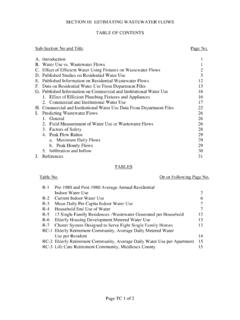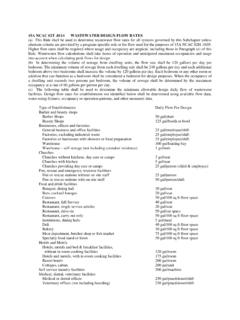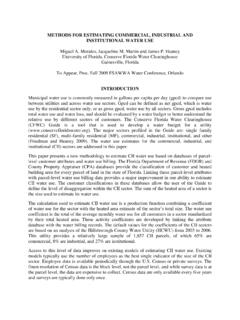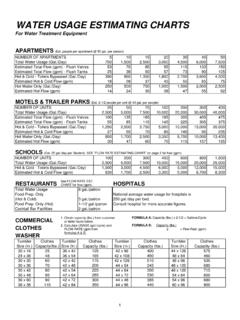Transcription of Guide for Estimating Infiltration and Inflow, June 2014
1 1 EPA New England water Infrastructure Outreach provides tools, examples, and technical assistance for water infrastructure operators and managers, local officials, and other decision-makers for more effective and sustainable water infrastructure management. For more information see Guide for Estimating Infiltration and Inflow June 2014 Purpose This Guide is intended to provide background and information for managers of wastewater collection systems on Estimating the amount of Infiltration and inflow (I&I) entering their collection system and for responding to National Pollutant Discharge Elimination System (NPDES) I&I permit reporting requirements.
2 This Guide provides methods for analyzing wastewater treatment plant influent flow data to estimate the I&I impact from the collection system as a whole. It will assist municipalities in ascertaining whether they have a significant I&I problem and, if so, what kind of problem they have. Areas (sewersheds) served by pump stations that are capable of recording flow can also be evaluated using these methods. Background There are three major components of wastewater flow in a sanitary sewer system, base sanitary (or wastewater) flow, groundwater Infiltration and rainfall derived inflow and Infiltration , more commonly referred to as inflow.
3 Virtually every sewer system has some Infiltration and/or inflow. Historically, small amounts of I&I are expected and tolerated. However, Infiltration and inflow may be considered excessive when it is the cause of overflows or bypasses, or the cost to transport and treat exceeds the cost to eliminate it. In cases where the I&I may not be considered excessive from a cost-to-eliminate perspective but causes health or environmental risks, corrective actions are required. Even where a system is not suffering from sanitary sewer overflows (SSOs), systems experiencing surcharging may be good candidates for further I&I investigation, as are systems where significant new growth is expected and existing collection system capacity may be inadequate or marginal for handling new customers.
4 State Revolving Loan Fund (SRF) applicants are generally required to evaluate the impacts of I&I on their overall system. This evaluation usually begins with an initial screening to determine whether a more complete I&I analysis will be required. The screening compares the sewered population to the treatment plant flow to determine gallons per day per person (gpdpp). The gpdpp is compared to a standard to determine if there is excessive Infiltration . The states standards vary between 100 and 150 gpdpp. The existing EPA guidance, which uses 120 gpdpp, was published in 1985 when gallon-per-flush toilets were standard (the Energy Policy Act of 1992 required that toilets installed in new construction use a maximum of gallon per flush (low-flow toilets)).
5 2 Some guidance documents use the term excessive Infiltration /inflow. This can mean quantities of I&I which can be economically eliminated from a sewer system as determined in a cost-effectiveness analysis that compares the costs for correcting the I&I conditions to the total costs for transportation and treatment of the Infiltration /inflow. I&I which causes SSOs is considered excessive. Municipalities will be well served to understand the dimensions and nature of any I&I problems. A clear set of goals is important for keeping an I&I program focused. The following is a sample of possible goals: To reduce ratepayer costs for transporting and treating wastewater by implementing all cost-effective I&I reduction projects within 10 years.
6 To minimize liability from water pollution and public health risks by eliminating sanitary sewer overflows in storm events. To eliminate sufficient I&I to avoid the capital costs of wastewater treatment plant capacity expansion in anticipation of 10% population growth over the next 20 years. To eliminate sufficient I&I to avoid the capital costs of interceptor expansion which will be needed to support the build-out of certain neighborhoods. To eliminate enough I&I to offset the environmental and regulatory impact of sewer system expansion and increased water demand over the next 15 years. In some cases, high levels of Infiltration can lower groundwater levels and can cause significant hydrologic impacts to nearby streams.
7 The health of tributary streams is critical to the health of main stem rivers, and reduced flows can impair the fish community by decreasing dissolved oxygen and available habitat, increasing water temperatures, and concentrating pollutant levels. Finally, just as collection system capacity problems may indicate excessive inflow, the same can be said for treatment plant capacity problems. Your state agency can provide you with treatment plant design standards which can then be compared with your influent flow data. The Ten States Standards for Wastewater Facilities is also a good reference source. Data Collection To assess extraneous water entering your system at least a year of influent flow data to the treatment facility should be examined.
8 For Infiltration analysis, flow data collected during the high groundwater periods is used. The Average Dry Weather (ADW) flow can be determined from analyzing a one to two week period during seasonal high water that is not influenced by rainfall. For the northeast, this is usually in the spring when the frost line is receding and the snow is melting. The ADW flow includes the sanitary flow plus Infiltration , which can be separated into its individual components. For inflow analysis, the Average Wet Weather (AWW) flow can be estimated from flow data for a one week period when there has been significant rain.
9 If a single storm event is used to analyze wet weather inflow, it should be an event large enough to cause surface ponding and runoff. 3 Definitions of terms used in Calculating Inflow and Infiltration Average Annual Flow - The total annual volume divided by 365 days. This value is approximated by the mean of the twelve monthly average flows . Average Annual Infiltration - The average of the monthly minimum flows . Average Annual Inflow - From the average annual flow, subtract the base sanitary flow and average annual Infiltration . Average Dry Weather Flow (ADW) - Flow during a period of extended dry weather (7 to 14 days) and seasonally high groundwater.
10 Flow includes sanitary flow and Infiltration , and excludes significant industrial and commercial flows (assumes no inflow during dry weather conditions). Base Sanitary Flow (BSF) - The portion of wastewater which includes domestic, commercial, institutional, and industrial sewage and specifically excludes Infiltration and inflow. (See Estimating Base Flow, below). Delayed Inflow volume - The portion of total inflow which is generated from indirect connections to the collection system or connections which produce inflow after a significant time delay from the beginning of a storm. Delayed inflow sources include: sump pumps, foundation drains, indirect sewer/drain cross-connections, etc.



















